Keeping your tires inflated to the correct air pressure not only increases your vehicle’s fuel efficiency but also makes your tires last longer.
Luckily, most car manufacturers equip their vehicles with tire pressure monitoring systems to help you stay informed about the current state of the air pressure in your tires.
But what if the system goes awry and starts sending false signals to your ECU?
This article will explain the various causes of a low tire pressure light coming up while the pressure is actually adequate inside the tires and what you can do to fix it.
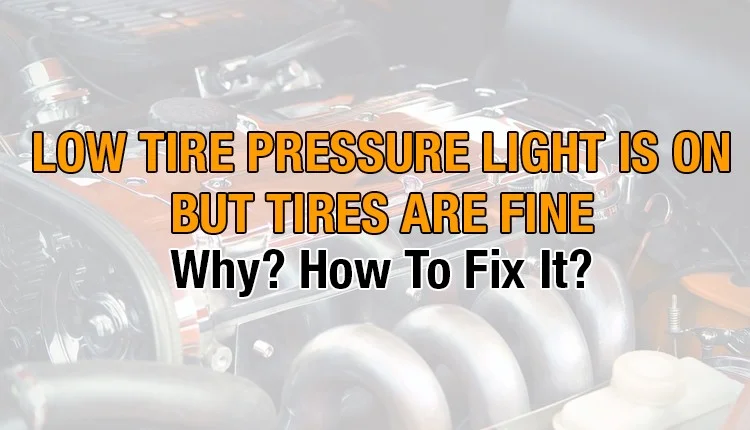
How Does A Tire Pressure Monitoring System Work?
If you want to find the causes of a wrong signal sent by one of the sensors, it’s essential to understand how the TPMS on your vehicle works.
The tire pressure monitoring system monitors the air pressure inside all the tires. It warns the driver with an audible or visual message in the instrument cluster when the tire pressure reaches a certain threshold.
Car manufacturers currently use two types of systems:
- Direct systems: These systems measure the tires’ internal pressure thanks to a sensor mounted on each rim. The sensors are physical pressure transducers attached to the base of the valve stem or as strips attached to the rim recess.
- Indirect systems: These systems use ABS sensors instead to measure the diameter of the wheel. A deflated tire will have a smaller diameter than normal and will turn faster than the other wheels. The main drawback with indirect systems is that, since they use the other tires’ size as a reference, they won’t be able to warn the driver if the pressure is low in all four tires at the same time.
Read more: What does low tire pressure light mean on Toyota vehicles?
Why Does The TPMS Light Come Up If The Tire Pressure Is Right?
The leading causes of a tire pressure monitoring light that comes on when the air pressure is adequate are as follows:
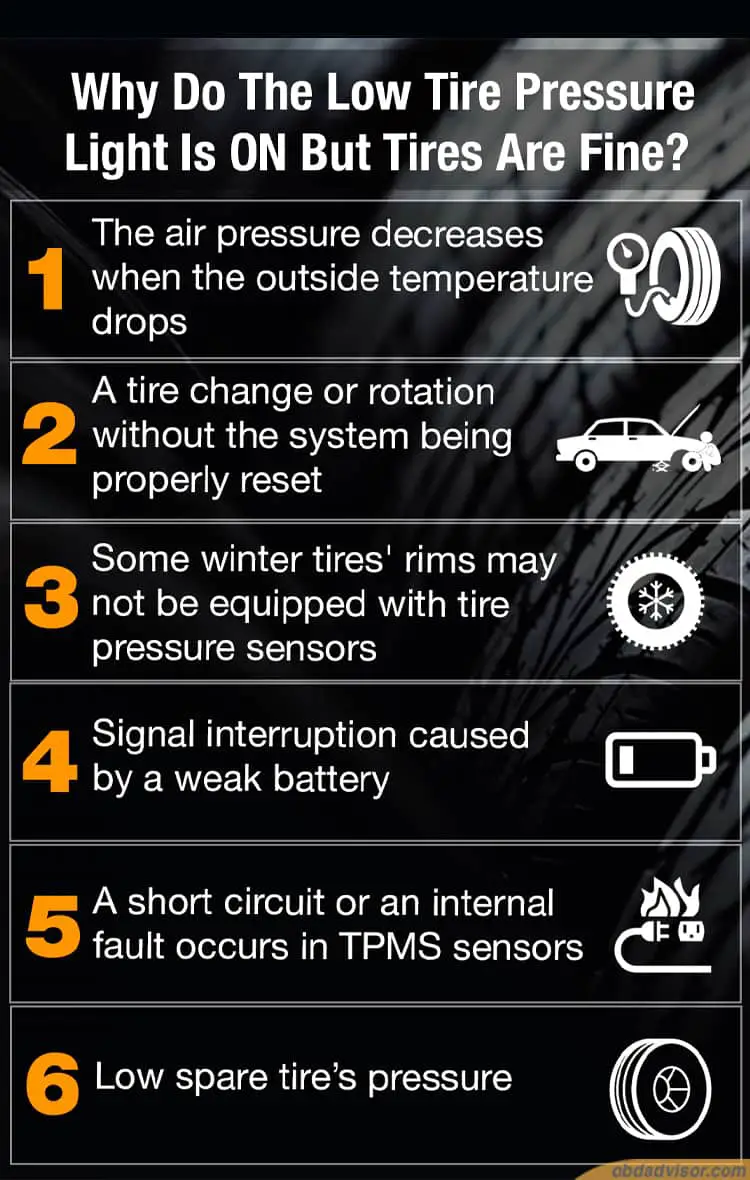
- Since the air pressure decreases when the outside temperature drops, significant temperature variations can activate the low tire pressure warning. For example, on a car with a tire pressure near the lower threshold limit, a freezing night can cause the TPMS light to come up for no reason the next morning. In such a case, the light should go out after driving for a couple of minutes, once the tires heat up and the pressure goes back to normal.
- A system malfunction warning message will be displayed if there is a tire change or rotation without the system being properly reset.
- If you just had your winter tires installed, the winter rims may not be equipped with tire pressure sensors, which will invariably light up the low-pressure warning light. Improper handling of the tires during replacement can also damage the sensors.
- Batteries power most OEM tire pressure sensors with a service life of 6 to 10 years. A weak battery may cause a signal interruption that will illuminate the low-pressure warning light.
- A substance other than air or nitrogen inserted into the tire, such as tire sealant to Fix-A-Flat spray, may damage the TPMS sensor. If you have used a tire sealant product to fix one of your TPMS-equipped tires, the sensor may be defective and no longer send any signal to the control module.
- Like all other electronic components, TPMS sensors use electronic circuits and devices that can deteriorate over time. If a short circuit or an internal fault occurs, the signal will cease to be communicated to the control module, which will cause the low-pressure light to come up.
- The pressure of the spare tire is low. Some spare tires are also equipped with a pressure sensor, and it is quite common to forget to check the pressure of the spare tire when adjusting the pressure of the other tires.
Identifying The Different TPMS Light Signals
It is essential to understand the different signals that the TPMS light sends you to know what you should do to correct a specific TPMS problem.
If the TPMS light comes on when you are driving, it indicates low pressure in at least one of your tires. Check the pressure of all your tires to see which tire needs to be inflated. The TPMS warning light will turn off automatically once the pressure is restored in all tires. If it does not go off, it means that one of the sensors has stopped sending a signal while driving. Such a situation might be caused by a defective sensor or a discharged battery.
A flashing TPMS warning light indicates that your tire pressure is approaching the lower threshold – normally around -20%. This situation usually happens when the pressure changes due to temperature fluctuations.
A TPMS warning light that flashes on start-up and stays on is frequently caused by an incorrect sensor programming or sensor failure. If your TPMS light flashes for 30 to 90 seconds, turning the ignition on, then stays on once your car is running, it means there’s a fault in the TPMS itself, or the control module is not receiving a signal from one or more than one sensor.
How To Fix A TPMS Light That Comes Up When The Tire Pressure Is Right
The first thing to check if your TPMS light comes on even when the tire pressure is adequate is the tire gauge itself. Tire pressure monitoring systems installed on modern vehicles are susceptible, and a deviation of +/- 2 psi may be sufficient to illuminate the warning light. Therefore, it is advisable only to use a digital manometer to measure and adjust the air pressure inside your tires. Most dial gauges aren’t accurate enough to correctly adjust tire pressure on a vehicle equipped with TPMS sensors.
When in doubt, and especially during wintertime, increasing your tire pressure by 2 to 4 psi may be enough to prevent temperature variations from causing the tire pressure warning light to light up in the morning.
When a sensor’s battery is discharged, it must be replaced. Unfortunately, it’s impossible to access the batteries contained inside pressure sensors equipping cars on roads nowadays. Therefore, the batteries can’t be tested without the help of an OBD2 scan tool. Moreover, as it is impossible to access batteries, a sensor whose battery is defective will need to be replaced anyway.
TPMS Sensors Relearn Procedures
If you have recently replaced or rotated the tires on your vehicle, the system may need to be reset to accommodate the new sensor locations. The same thing applies if a defective sensor has been replaced. New sensors must always be reprogrammed with the specific system of each vehicle.
There are several different techniques for resetting or reprogramming sensors depending on the car manufacturer. The required procedure is usually described in the owner’s manual. Here are the most common procedures:
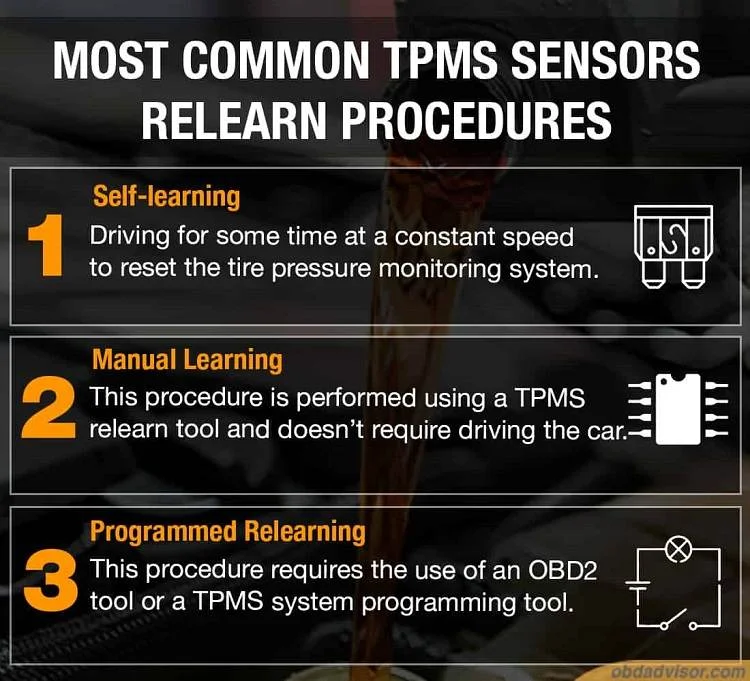
Self-learning
On many vehicles, driving for some time at a constant speed is enough to reset the tire pressure monitoring system. Drive your car for 5 to 10 minutes at over 60 km/h and watch the TPMS light. If it goes out, your problem is fixed. If not, go to the next step.
Manual Learning
This procedure is performed using a TPMS relearn tool and doesn’t require driving the car. Each vehicle comes with a specific procedure to enter the learning mode. Once in learning mode, an activation tool, often in the form of a Bluetooth dongle, identifies each sensor and programs each sensor into the control module, including the spare tire if necessary.
Programmed Relearning
This relearning procedure is the most complicated one since the sensors are programmed by establishing a connection with the on-board diagnostic interface. This procedure requires the use of an OBD2 tool or a TPMS system programming tool. Relearning these sensors frequently requires the assistance of an automotive technician.
The Bottom Line
Having the latest technical innovations installed on your vehicle sure brings many benefits as long as you keep them in good working order. The same applies to tire pressure monitoring systems. The next time you stop by your mechanic for your vehicle’s fixed-interval maintenance appointment or your next winter tires installation, make sure he inspects and maintains the TPMS to ensure it stays in good shape for as long as possible. Nonetheless, even the best care won’t prevent electronic components from failing once in a while. When it happens, and the TPMS light comes up when the air pressure inside your tires is right, understanding how the tire pressure monitoring system on your car works will help you figure out what’s wrong and how you can fix it. Doing so will help you save tons of time and money in the end. Never forget that knowledge is power, and it’s even more so when it comes to automotive maintenance.
Read more: High Oil Pressure: Meaning, Causes, Symptoms, and Fix Guide

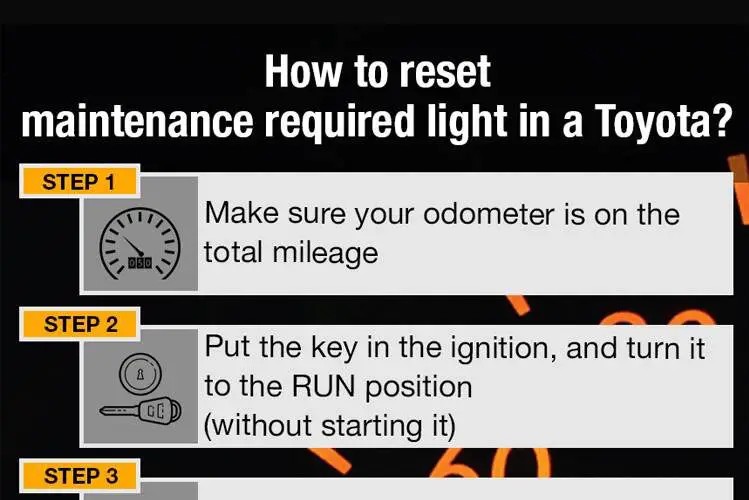
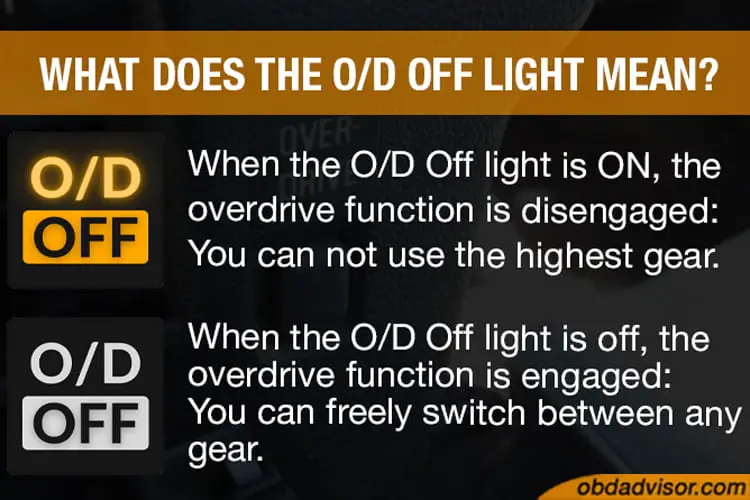
Recommended for you
Volvo Dashboard Symbols and Meanings
Kenworth Dashboard Lights and Meanings
Freightliner Warning Lights and Meanings